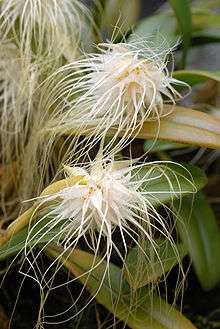Bulbophyllum medusae
Bulbophyllum medusae, commonly known as the Medusa orchid is a species of epiphytic orchid with a creeping rhizome and a single leaf about 100 mm (3.9 in) long emerging from the top of each pseudobulb. The flowers are creamy yellow and arranged in cluster of about fiften arranged in a circle at the tip of the flowering stem. The flowers have an unpleasant odour. The flowers have thread-like lateral sepals about 120 mm (4.7 in) long, giving each cluster of flowers the appearance of Medusa.[2]
| Medusa orchid | |
|---|---|
 | |
| Scientific classification | |
| Kingdom: | Plantae |
| Clade: | Tracheophytes |
| Clade: | Angiosperms |
| Clade: | Monocots |
| Order: | Asparagales |
| Family: | Orchidaceae |
| Subfamily: | Epidendroideae |
| Tribe: | Dendrobieae |
| Genus: | Bulbophyllum |
| Species: | B. medusae |
| Binomial name | |
| Bulbophyllum medusae | |
| Synonyms[1] | |
The Medusa orchid was first formally described in 1861 by John Lindley who gave it the name Cirrhopetalum medusae and published the description in Edwards's Botanical Register.[3][4] In 1861, Heinrich Gustav Reichenbach changed the name to Bulbophyllum medusae.[1]
Bulbophyllum medusae grows on the trunk and main branches of trees in forest at altitudes up to 400 m (1,300 ft) in Thailand, Malaysia, Borneo, the Lesser Sunda Islands and Sumatra.[2]
References
- "Bulbophyllum medusae". World Checklist of Selected Plant Families (WCSP). Royal Botanic Gardens, Kew.
- "Bulbophyllum medusae". Singapore Government National Parks Board. Retrieved 14 December 2018.
- "Cirrhopetalum medusae". World Checklist of Selected Plant Families (WCSP). Royal Botanic Gardens, Kew.
- Lindley, John (1842). "Cirrhopetalum medusae". Edwards's Botanical Register. 28: 12. Retrieved 14 December 2018.
External links
